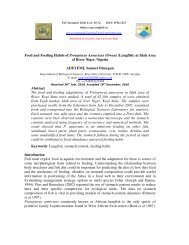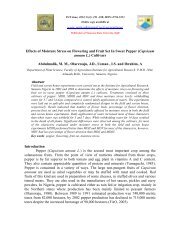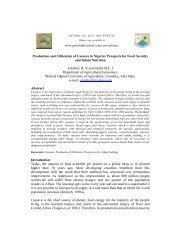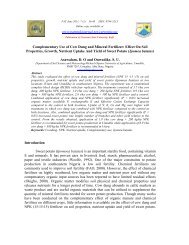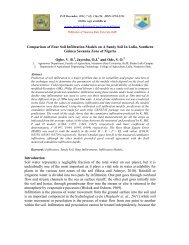The Replacement Value of Pigeon Pea (Cajanus Cajan) For Maize ...
The Replacement Value of Pigeon Pea (Cajanus Cajan) For Maize ...
The Replacement Value of Pigeon Pea (Cajanus Cajan) For Maize ...
Create successful ePaper yourself
Turn your PDF publications into a flip-book with our unique Google optimized e-Paper software.
PAT 2009; 5 (1): 67-74 ISSN: 0794-5213<br />
Online copy available at<br />
www.patnsukjournal.net/currentissue<br />
Publication <strong>of</strong> Faculty <strong>of</strong> Agriculture, Nasarawa State University, Keffi<br />
<strong>The</strong> <strong>Replacement</strong> <strong>Value</strong> <strong>of</strong> <strong>Pigeon</strong> <strong>Pea</strong> (<strong><strong>Cajan</strong>us</strong> <strong>Cajan</strong>) <strong>For</strong> <strong>Maize</strong> on Performance<br />
<strong>of</strong> Broiler Finishers<br />
Iorgyer*, M.I., Odoh, O.E., Ikondo, N.D. and Okoh, J.J<br />
Department <strong>of</strong> Animal Health and Production, Akperan Orshi College <strong>of</strong> Agiculture,<br />
Yandev, PMB 181, Gboko. Benue State<br />
*Corresponding Author (Email - davidiorgyer@yahoo.com Tel 08024596661)<br />
Abstract<br />
One hundred and fifty, 4-weeks old unsexed broiler chickens were used in a 28 day trial to evaluate the<br />
effect <strong>of</strong> replacing maize with pigeon pea in broiler finisher diets. <strong>The</strong> birds were randomly allocated to 5<br />
dietary treatments with each treatment having 30 birds replicated three times. Each replicate contained<br />
10 birds. Diet 1 was formulated without pigeon pea and served as control. <strong>Pigeon</strong> pea replaced on weight<br />
to weight basis, 25, 50, 75 and 100% respectively <strong>of</strong> the maize in the control diet to give diets 2, 3, 4 and<br />
5. Feed intake, weight gain, feed conversion ratio, carcass yield and feed cost/kg gain were determined to<br />
compare treatment means. Results obtained for diets 1, 2, 3, 4 and 5 showed that feed intake (114.99 g,<br />
104.29 g, 114.17 g, 108.71 g and 105.03 g) weight gain (38.65 g, 39.85 g, 38.18 g, 37.69 g and 31.69 g)<br />
and feed conversion ratio (2.98, 2.62, 2.99, 2.88 and 3.32) <strong>of</strong> birds on all dietary treatments were<br />
comparable. Carcass yield <strong>of</strong> birds on 100% replacement level (52.62%) was significantly (P
PAT 2009; 5(1): 67-74<br />
ISSN: 0794-5213; Iorgyer et al; <strong>The</strong> <strong>Replacement</strong> <strong>Value</strong> <strong>of</strong> <strong>Pigeon</strong> <strong>Pea</strong> …….68<br />
<strong>Pigeon</strong> pea (<strong><strong>Cajan</strong>us</strong> cajan) is one <strong>of</strong> the most common legumes <strong>of</strong> the tropics and subtropics<br />
with a wide adaptability (Wallies and Byth, 1988). Rachie (1975) reported that<br />
pigeon pea is a legume that shows great potential in Nigeria and to which efforts <strong>of</strong> the<br />
International Institute <strong>of</strong> Tropical Agriculture (IITA) were directed for improvement.<br />
<strong>Pigeon</strong> pea is truly a multipurpose nitrogen fixing plant that provides food, fuel wood,<br />
fodder and shelter material to subsistence farmers. <strong>The</strong> seeds can be used as animal feed<br />
and harvest trash consisting <strong>of</strong> shells, leaf and young stems has good fodder value.<br />
<strong>Pigeon</strong> pea is drought tolerant and has greater adaptability to poor soil conditions than<br />
most tropical legumes (Akinola and Oyejola, 1994). It is widely cultivated throughout<br />
the tropics as a cover crop or green manure crop and it has high dry matter yield<br />
potential. Aduku (1993) gave the nutritional composition <strong>of</strong> pigeon pea seed as: 23.77%<br />
CP, 1.1% fat, 7.49% CF, 0.13% Ca, 0.28% P, 1.66% lysine, 0.36% methionine, 0.29%<br />
cystein, 1.59% arginine and 0.11% tryptophan. <strong>Pigeon</strong> peas low food value for humans<br />
due to low palatability when compared to cowpea and prolonged cooking time, coupled<br />
with no industrial use in Nigeria as <strong>of</strong> now (Amaefule and Obioha, 2001), qualifies it as<br />
a suitable replacement for maize. Iorgyer et al (2008) replaced 0, 25, 50, 75 and 100%<br />
<strong>of</strong> weaner rabbit diets with pigeon pea and recorded no significant (P>0.05) difference<br />
among treatments on rabbit performance. <strong>The</strong>y however reported feed cost /kg gain on<br />
pigeon pea based diets to be significantly (P
PAT 2009; 5(1): 67-74<br />
ISSN: 0794-5213; Iorgyer et al; <strong>The</strong> <strong>Replacement</strong> <strong>Value</strong> <strong>of</strong> <strong>Pigeon</strong> <strong>Pea</strong> …….69<br />
Experimental Procedure<br />
<strong>The</strong> poultry house was cleaned, washed, disinfected and dried before use. Birds were<br />
individually weighed at the commencement <strong>of</strong> the trial and subsequently on weekly<br />
basis to monitor their weight. Birds were given their group diet and water adli bitum.<br />
Left over feed was weighed and subtracted from the feed served to arrive at feed intake.<br />
At the end <strong>of</strong> the 28 day study, 3 birds weighing close to their pen average were starved<br />
overnight, sacrificed by severing the jugular vein with a sharp knife and allowed to<br />
bleed by gravity. <strong>The</strong>y were scalded, defeathered, envicerated and weighed to obtain<br />
dressed weight.<br />
Parameters Measured<br />
Mean daily feed intake (g), Mean daily weight gain (g), feed conversion ratio (g feed/ g<br />
gain), carcass yield (dressing percentage ,%), feed cost/ kg (₦/kg) and feed cost/ kg gain<br />
(₦/kg), were the parameters measured to compare treatment means.<br />
Proximate Analysis<br />
Samples <strong>of</strong> the test material (pigeon pea, raw and boiled) and experimental diets were<br />
analysed chemically for proximate components according to AOAC (1990). All<br />
analysis was carried out in duplicate.<br />
Data Analysis<br />
Data collected were subjected to ANOVA for Complete Randomized Design (CRD).<br />
Differences between treatments were separated using Hsus MCB (Multiple<br />
Comparable with the Best) method (MINITAB, 1991).<br />
Results and Discussion<br />
<strong>The</strong> nutritional characteristics <strong>of</strong> pigeon pea and the experimental diets are in Tables 1<br />
and 2 respectively. <strong>Pigeon</strong> pea had high dry matter content. <strong>The</strong> metabolizable energy<br />
(ME Kcal/kg) <strong>of</strong> the raw seed was very high (3265) which was further increased with<br />
boiling to 3355. <strong>The</strong> metabolizable energy <strong>of</strong> pigeon pea is close to that <strong>of</strong> maize (3400<br />
kcal/kg, Aduku, 1993), therefore qualifies it as a suitable replacement for maize as<br />
energy source in poultry diets. Considering the percent ingredient composition <strong>of</strong> the<br />
tests diets, crude protein and other nutrients (both in determined and calculated<br />
analysis) increased while energy decreased as the level <strong>of</strong> replacement increased. This<br />
could be probably because pigeon pea has higher crude protein and other nutrients and<br />
lower energy than maize (Aduku, 1993). However both calculated and determined<br />
values are within the range <strong>of</strong> nutrient requirement <strong>of</strong> broiler finishers according to<br />
Aduku (1993) and Olomu (1995).<br />
<strong>The</strong> performance, meat yield and economics <strong>of</strong> producing broiler finishers on tests diets<br />
are in Table 3. Feed intake, weight gain and feed conversion ratio <strong>of</strong> birds on pigeon
PAT 2009; 5(1): 67-74<br />
ISSN: 0794-5213; Iorgyer et al; <strong>The</strong> <strong>Replacement</strong> <strong>Value</strong> <strong>of</strong> <strong>Pigeon</strong> <strong>Pea</strong> …….70<br />
pea containing diets were not significantly (P>0.05) different from those on the control<br />
diet. Birds are known to eat to meet their energy requirements, and since the energy<br />
levels <strong>of</strong> all the diets in this study were similar, feed intake <strong>of</strong> birds were also similar.<br />
<strong>The</strong> similarity in the feed intake, weight gain feed conversion ratio <strong>of</strong> birds on all diets<br />
in this study is an indication that pigeon pea is not inferior to maize. This agrees with<br />
Amaefule and Obioha (1998) that broiler finishers can perform well with up to 50% <strong>of</strong><br />
pigeon pea seed meal in their diets. This result however differed from results <strong>of</strong><br />
Grimaud (1988) and Ologbobo (1992), who reported depressed growth rate, increased<br />
feed intake and poor feed conversion efficiency <strong>of</strong> broilers fed with above 25% level <strong>of</strong><br />
boiled pigeon pea seed meal in their diets.<br />
Significant differences were observed in live weight <strong>of</strong> birds with birds on 0%<br />
replacement level being significantly (P
PAT 2009; 5(1): 67-74<br />
ISSN: 0794-5213; Iorgyer et al; <strong>The</strong> <strong>Replacement</strong> <strong>Value</strong> <strong>of</strong> <strong>Pigeon</strong> <strong>Pea</strong> …….71<br />
the current demand pressure on maize and also reducing the cost <strong>of</strong> broiler finisher<br />
diets.<br />
References<br />
Aduku, A, O. (1993): Tropical Feedstuff Analysis Table. Department <strong>of</strong> Animal<br />
Science, Faculty <strong>of</strong> Agriculture, Ahmadu Bello University, Samaru- Zaria,<br />
Nigeria.<br />
Akinola, J. O. and Oyejola, A. (1994): Planting date and density effect <strong>of</strong> six pigeon pea<br />
cultivars at three Nigerian Savannah locations. Journal <strong>of</strong> Agricultural<br />
Science, 123: 233-264.<br />
Amaefule, K, U. and Obioha, F. C. (1998): <strong>The</strong> substitution <strong>of</strong> pigeon pea (<strong><strong>Cajan</strong>us</strong><br />
cajan) for groundnut and maize in broiler finisher rations. Nigerian Journal <strong>of</strong><br />
Animal Production, 25(1): 9-12.<br />
Amaefule, K. U. and Obioha, F. C. (2001): Performance and nutrient utilization <strong>of</strong><br />
broiler starters fed diets containing raw, boiled and dehulled pigeon pea seeds.<br />
Nigerian Journal <strong>of</strong> Animal Production, 28(1):31-39.<br />
AOAC. (1990): Association <strong>of</strong> Official Analytical Chemists. Official Methods <strong>of</strong><br />
Analysis. 15 th ed. Washington D.C.<br />
Bamgbose, A. M., Ogungbenrom S. D., Obasoban, E. E., Aruna, M. B., Oteku, I. T.,<br />
Igene, U. R., Otoikhian, C. S. O. and Imasuen, J. A. (2004): <strong>Replacement</strong><br />
value <strong>of</strong> maize <strong>of</strong>fal/cashew nut for maize in broiler diet. Proceedings <strong>of</strong> the<br />
29 th Annual Conference <strong>of</strong> the Nigerian Society for Animal Production,<br />
29:219-221.<br />
Durunna, C.S., Udedibie, A.B.I. and Uchegbu, M.C. (2005): Effect <strong>of</strong> dietary inclusion<br />
<strong>of</strong> Anthonata macrophyla meal on the performance <strong>of</strong> broiler starter chicks.<br />
Nigerian Journal <strong>of</strong> Animal Production, 32(2): 268-273.<br />
Esonu, B. O. and Udedibie, A. B. I. (1993): <strong>The</strong> effect <strong>of</strong> replacing maize with cassava<br />
peel meal on the performance <strong>of</strong> weaned rabbits. Nigerian Journal <strong>of</strong> Animal<br />
Production, 20.<br />
Etuk, E.B. and Udedibie, A.B.I. (2006): Effect <strong>of</strong> cooked pigeon pea seed meal on the<br />
performance, dressed and organ weight characteristics <strong>of</strong> broilers. Nigerian<br />
Journal <strong>of</strong> Animal Production, 33(1): 16-22.<br />
Grimaud, P. (1988): <strong>The</strong> pigeon pea (<strong><strong>Cajan</strong>us</strong> cajan). A possible alternative for<br />
traditional pig and poultry farming in New Caledonia. Revued’ Elevage-et- de<br />
Medicine Veterinarede- Nouvelle, Caledonie, 11, 29-36.<br />
Iorgyer, M. I., Carew, S. N. and Ayoade, J. A. (2008): <strong>The</strong> replacement value <strong>of</strong> pigeon<br />
pea (<strong><strong>Cajan</strong>us</strong> cajan) for maize in weaner rabbit diets. Proceedings <strong>of</strong> the 31 st<br />
Annual Conference <strong>of</strong> the Animal Science Association <strong>of</strong> Nigeria held at<br />
A.B.U. Zaria. September 15 th -19 th . Pp 456-45
PAT 2009; 5(1): 67-74<br />
ISSN: 0794-5213; Iorgyer et al; <strong>The</strong> <strong>Replacement</strong> <strong>Value</strong> <strong>of</strong> <strong>Pigeon</strong> <strong>Pea</strong> …….72<br />
MINITAB (1991): Minitab Statistical S<strong>of</strong>tware Reference Manual, P.C. Version,<br />
Release 8, Media Cybernetics Inc, New York.<br />
Ogbonna, J. U. and Adebowale, E. A. (1993): Effect <strong>of</strong> sun -dried cassava peel meal as<br />
replacement for maize and wheat <strong>of</strong>fals on performance and nutrient<br />
utilization <strong>of</strong> cockerels. Nigerian Journal <strong>of</strong> Animal Production, 20.<br />
Ologbobo, A.D. (1992): <strong>The</strong> nutritive value <strong>of</strong> some tropical (West African) legumes<br />
for poultry. Journal <strong>of</strong> Applied Animal Research, 2: 93-104.<br />
Olomu, J. M. (1995): Monogastric Animal Nutrition. A Jachen Publication, Benin City,<br />
Nigeria, Pp. 141-145.<br />
Pauzenga, U. (1985): Feeding parent stock. Journal <strong>of</strong> Zoological Technology<br />
International, December, Pp. 22-24.<br />
Rachie, K. O. (1975): <strong>The</strong> nutritional role <strong>of</strong> grain legumes in lowland humid Tropics.<br />
In: Biological fixation in farming systems <strong>of</strong> the Tropics. Ayabana, A. and<br />
Dart, P. J. (eds). Based on papers presented at a symposium held at IITA,<br />
Ibadan, Nigeria, Pp. 272-275.<br />
Sogunle, O.M., Fanimo, A.O., Biobaku, W.O. and Bamgbose, A.M. (2005): <strong>The</strong><br />
feeding value <strong>of</strong> full fat cashew nut (Anacardium occidentale Linn) rejects and<br />
low cereal diets for broiler chickens. Nigerian Journal <strong>of</strong> Animal Production,<br />
32(1): 46-53.<br />
Tuleun, C. D., Njike, M. C., Ikurior, S. A. and Ehiobu, N. G. (2005): <strong>Replacement</strong> <strong>of</strong><br />
maize with cassava root meal/brewers yeast slurry in the diets <strong>of</strong> broiler<br />
chickens. Proceedings <strong>of</strong> the 30 th Annual Conference <strong>of</strong> the Nigerian<br />
Association for Animal Production, held at University <strong>of</strong> Nigeria, Nsukka.<br />
March, 20 th -24 th .<br />
Udedibie, A. B. I. and Asoluka, O. C. (2008): Effects <strong>of</strong> 5- hour wetting <strong>of</strong> sun dried<br />
cassava tuber meal on the HCN content and dietary value <strong>of</strong> the meal for<br />
young broiler chickens. Nigerian Journal for Animal Production, 35(1):25-31.<br />
Ugwuene, M.C., Onwudike, O.C., Abasiekong, S.F. and Nnadiekwe, C.M. (2005):<br />
Effect <strong>of</strong> replacing maize with full fat palm kernel meal in broiler diets.<br />
Proceedings <strong>of</strong> the 30 th Annual Conference <strong>of</strong> the Nigerian Society for Animal<br />
Production, held at University <strong>of</strong> Nigeria, Nsukka, March 20 th 24 th . Pp. 179-<br />
182.
PAT 2009; 5(1): 67-74<br />
ISSN: 0794-5213; Iorgyer et al; <strong>The</strong> <strong>Replacement</strong> <strong>Value</strong> <strong>of</strong> <strong>Pigeon</strong> <strong>Pea</strong> …….73<br />
Table 1:<br />
Proximate composition <strong>of</strong> pigeon pea seeds<br />
% Raw Boiled<br />
Dry matter 88.69 89.73<br />
Crude protein 21.25 19.86<br />
Crude fibre 6.65 4.40<br />
Crude fat 1.41 1.52<br />
Ash 4.11 3.91<br />
NFE 66.58 70.31<br />
ME* (kcal/kg) 3265.00 3355.00<br />
ME (kcal/kg) = 37 x %CP + 81.8 x % EE + 35.5 x %NFE (Pauzenga, 1985)<br />
NFE determined by difference: NFE=100-(%CP+%CF+%EE+%Ash)<br />
Table2: Percent ingredient composition <strong>of</strong> broiler finisher diets <strong>Maize</strong> <strong>Replacement</strong> Level (%)<br />
Ingredients 0 25 50 75 100<br />
<strong>Maize</strong> 51.31 38.48 25.65 12.83 -<br />
<strong>Pigeon</strong> pea - 12.83 25.66 38.48 51.31<br />
Soyabeans 39.69 39.69 39.69 39.69 39.69<br />
Rice <strong>of</strong>fal 5.00 5.00 5.00 5.00 5.00<br />
Bone meal 3.20 3.20 3.20 3.20 3.20<br />
Salt 0.30 0.30 0.30 0.30 0.30<br />
Premix 0.25 0.25 0.25 0.25 0.25<br />
Methionine 0.25 0.25 0.25 0.25 0.25<br />
Total 100.00 100.00 100.00 100.00 100.00<br />
Calculated values<br />
Crude protein (%) 20.00 21.41 22.82 24.23 25.34<br />
Crude fibre (%) 4.84 5.14 5.45 5.76 6.09<br />
Calcium (%) 1.27 1.36 1.30 1.31 1.33<br />
Phosporus (%) 0.95 0.95 0.95 0.95 0.94<br />
Lysine (%) 1.09 1.27 1.45 1.63 1.81<br />
Methionine (%) 0.57 0.59 0.61 0.63 0.65<br />
Meth + Cys (%) 0.86 0.90 0.94 0.98 1.01<br />
ME (kcal/kg) 3120 3115 3109 3103 3095<br />
Determined values<br />
Dry matter (%) 90.09 90.07 90.16 90.14 90.12<br />
Crude protein (%) 20.31 20.33 20.52 20.44 20.67<br />
Crude fat (%) 3.5 3.54 3.59 3.63 3.57<br />
Crude fibre (%) 3.5 3.54 3.52 3.58 3.60<br />
Ash (%) 6.01 6.10 6.16 6.22 6.20
PAT 2009; 5(1): 67-74<br />
ISSN: 0794-5213; Iorgyer et al; <strong>The</strong> <strong>Replacement</strong> <strong>Value</strong> <strong>of</strong> <strong>Pigeon</strong> <strong>Pea</strong> …….74<br />
Table 3: <strong>The</strong> treatment effect <strong>of</strong> replacing maize with pigeon pea on performance,<br />
meat yield and economics <strong>of</strong> producing broiler finishers<br />
<strong>Maize</strong> <strong>Replacement</strong> Level (%)<br />
Parameters 0 25 50 75 100 SEM<br />
Initial live wt (g/bird) 461.36 458.50 456.30 450.57 453.30 -<br />
Mean daily feed intake (g) 114.99 104.29 114.17 108.71 105.03 11.96<br />
Mean daily wt gain (g) 38.65 39.85 38.18 37.69 31.67 9.64<br />
Feed conversion ratio 2.98 2.62 2.99 2.88 3.32 1.07<br />
Mean live weight (g) 1550.0 a 1400.0 b 1483.3 ab 1483.3 ab 1216.7 c 34.16<br />
Mean dressed wt (g) 1071.7 a 950.0 a 1033.3 a 1000.0 a 713.3 b 28.46<br />
Carcass yield (dressed %) 69.13 a 67.83 a 69.66 a 67.41 a 58.62 b 0.69<br />
Feed cost (N/ kg) 87.48 84.91 82.35 79.78 77.22 -<br />
Feed cost/ kg gain (N/ kg) 260.69 222.46 246.23 229.77 299.84 -<br />
Saving on feed cost/kg<br />
Gain (N) 00.00 38.23 14.46 30.92 -39.15 -<br />
a,b,c Means in a row with different superscripts are significantly (P



